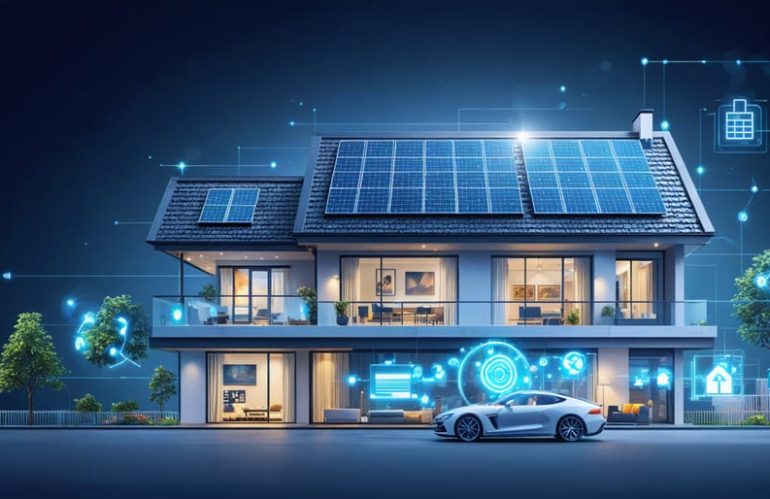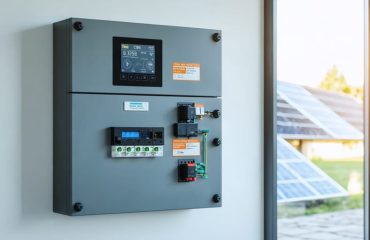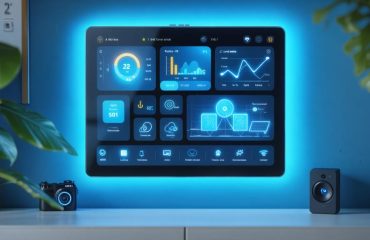Advanced battery technology is revolutionizing home energy storage, making solar power more practical and affordable than ever before. Today’s cutting-edge batteries deliver up to three times the lifespan of traditional systems while requiring minimal maintenance, fundamentally changing how homeowners approach designing the perfect home solar system.
The latest lithium-ion batteries feature intelligent power management systems that automatically optimize charging cycles and energy distribution, significantly reducing electricity bills while providing reliable backup power during outages. These smart systems can now predict your household’s energy needs, adjust to weather patterns, and even communicate with smart home devices to maximize efficiency.
What’s truly exciting is the rapid pace of innovation in this field. New solid-state batteries, currently in development, promise even greater energy density, faster charging times, and enhanced safety features. These advancements, combined with dropping prices and improved reliability, make now the ideal time for homeowners to invest in advanced battery storage solutions that will power their homes well into the future.
How Today’s Solar Batteries Keep Your Lights On
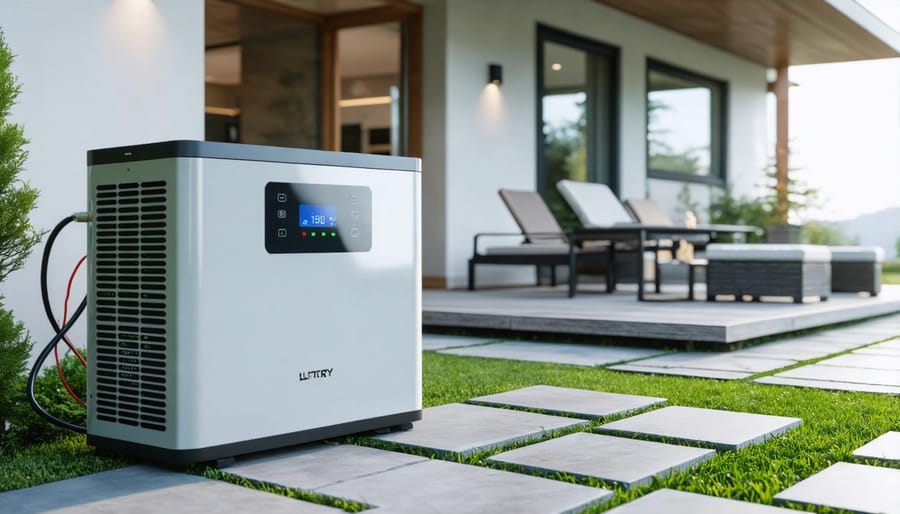
Lithium-Ion vs. Traditional Batteries
When comparing lithium-ion batteries to traditional lead-acid batteries, the differences are striking – especially for homeowners looking to maximize their energy storage potential. Lithium-ion batteries last significantly longer, typically providing 10-15 years of reliable service compared to just 5-7 years for lead-acid alternatives. They’re also much more efficient, converting up to 95% of stored energy into usable power, while traditional batteries typically achieve only 80-85% efficiency.
Space-conscious homeowners will appreciate that lithium-ion batteries take up about half the space of their traditional counterparts while weighing considerably less. They also require virtually no maintenance, unlike lead-acid batteries that need regular water level checks and terminal cleaning.
Perhaps most importantly for daily use, lithium-ion batteries can be discharged more deeply without damage – up to 80% of their capacity compared to just 50% for lead-acid batteries. This means you get more usable energy from a similarly-sized system. While the initial investment is higher, the longer lifespan and better performance make lithium-ion batteries the more cost-effective choice for most home energy storage applications.
Smart Features That Protect Your Investment
Today’s advanced battery systems come equipped with sophisticated monitoring features that protect your investment and optimize performance. These intelligent systems continuously track battery health, charging cycles, and energy flow, giving you real-time insights through user-friendly mobile apps. Just like other smart solar upgrades, these monitoring systems help prevent potential issues before they become problems.
Built-in temperature control mechanisms ensure your batteries operate within safe limits, while automated management systems optimize charging and discharging patterns to extend battery life. Many systems now include predictive maintenance alerts that notify you when service might be needed, helping you avoid unexpected downtime.
The latest battery technology also features advanced surge protection and emergency shutdown capabilities, safeguarding your system during extreme weather events or grid fluctuations. These protective features work together with smart load management, automatically prioritizing essential appliances during power outages and ensuring you get the most value from your stored energy.
Remote monitoring capabilities allow both you and your service provider to keep an eye on system performance, making maintenance simpler and more proactive than ever before.
Real Benefits for Your Home
Power Outage Protection That Actually Works
Modern battery systems have revolutionized how we handle power outages, offering reliable backup power that kicks in seamlessly when the grid goes down. Unlike traditional generators, today’s battery solutions activate instantly – within milliseconds of detecting an outage – ensuring your essential appliances and devices stay running without interruption.
What makes these systems truly effective is their smart power management capabilities. They automatically prioritize critical loads like refrigerators, medical equipment, and home security systems while managing energy consumption to extend backup duration. Most modern systems can power a typical home for 24-48 hours, with the ability to recharge through solar panels even during extended outages.
The reliability factor has improved dramatically with lithium-ion technology. These batteries maintain their performance consistently throughout their 10+ year lifespan, unlike older lead-acid batteries that degraded quickly. They’re also maintenance-free and operate silently, making them ideal for residential use.
Weather monitoring and smart features add another layer of protection. Many systems can track incoming storms and automatically prepare by ensuring full charge levels. Some even learn your household’s energy patterns to optimize backup power distribution when you need it most.
For homeowners, this means true peace of mind during outages – no more spoiled food, no disrupted work-from-home setups, and no loss of critical services when the grid fails.
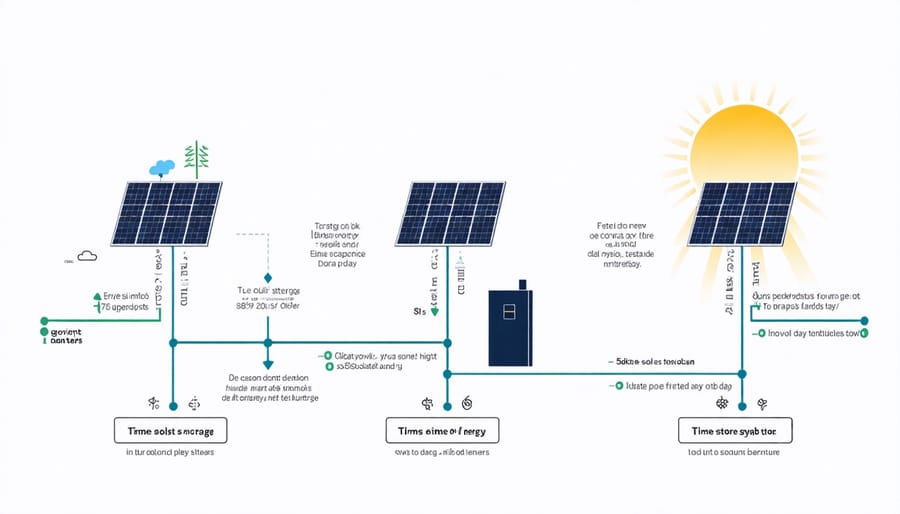
Lower Electric Bills Through Smart Energy Management
One of the most compelling benefits of advanced battery systems is their ability to significantly reduce your monthly electricity bills through strategic energy management. These systems excel at “peak shifting” – storing energy when rates are low and using it during expensive peak hours. Think of it as buying groceries when they’re on sale to use later when prices are higher.
During off-peak hours, typically late at night or early morning, your battery system automatically charges using cheaper grid electricity or stored solar power. When peak rates kick in during high-demand periods (usually late afternoon and evening), your home draws power from the battery instead of the grid, avoiding those premium prices.
This practice, known as energy arbitrage, can lead to substantial savings, especially in areas with time-of-use pricing. Combined with smart home integration, your battery system can optimize energy usage patterns automatically, maximizing your savings without requiring constant attention.
Many homeowners report seeing their electric bills drop by 30% or more after implementing these smart energy management strategies. The system’s ability to predict usage patterns and automatically adjust to rate changes means you’re always getting the most cost-effective power available, whether it’s from your solar panels, stored battery power, or the grid.
Making the Most of Your Battery System
Setting Up Your System for Success
To get the most from your advanced battery system, proper configuration is essential. Start by placing your batteries in a temperature-controlled environment, ideally between 60-80°F (15-27°C). This helps maintain optimal performance and extends battery life. Consider installing a dedicated ventilation system to regulate temperature and prevent moisture buildup.
Next, ensure your battery management system (BMS) is correctly calibrated. This smart controller helps optimize your solar system by managing charging cycles and preventing overcharging or deep discharge.
Position your batteries close to both your solar inverter and main electrical panel to minimize power loss through cables. Use high-quality, properly sized cables and ensure all connections are secure and protected from the elements. Consider installing a monitoring system that alerts you to any performance issues or maintenance needs.
For homes in areas with frequent power outages, configure your system to automatically switch to battery power when needed. This ensures a seamless transition and protects your essential appliances from sudden power loss.
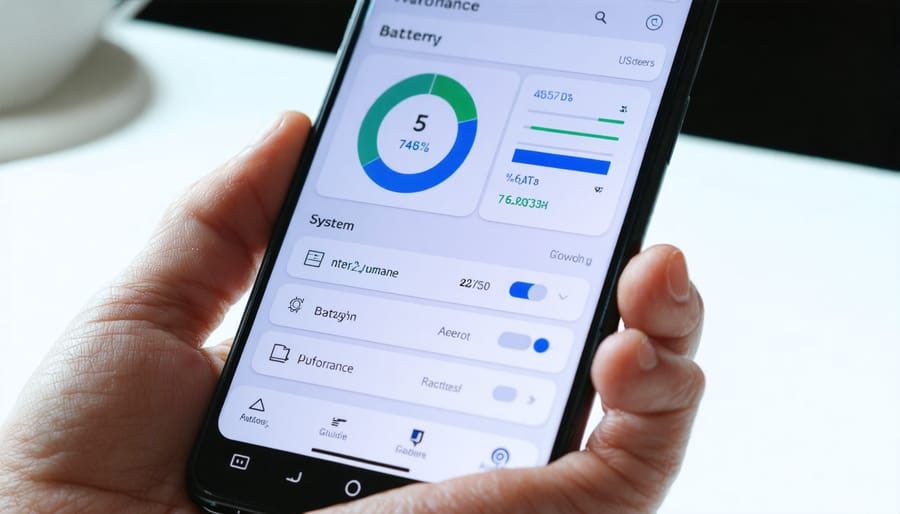
Simple Maintenance Tips
Maintaining your advanced battery system doesn’t have to be complicated. With these simple tips, you can maximize your battery’s lifespan and performance. First, keep your battery installation area clean and well-ventilated, ensuring temperatures remain moderate. Excessive heat or cold can significantly impact battery efficiency.
Monitor your battery’s charge levels regularly through your system’s app or display panel. Avoid frequently depleting the battery completely – maintaining a charge between 20% and 80% is ideal for most systems. Schedule regular visual inspections to check for any signs of physical damage or unusual swelling.
Keep detailed records of your battery’s performance and any maintenance performed. This helps track patterns and identify potential issues early. Many modern systems include automated monitoring, but it’s still worth checking the physical components monthly.
For seasonal maintenance, ensure any outdoor components are protected from extreme weather. Clean any dust or debris from vents and cooling systems. If you notice any unusual sounds, smells, or performance changes, contact your installer immediately. Most battery systems require minimal hands-on maintenance, but these simple steps can help ensure optimal performance for years to come.
Future-Proof Your Home Energy System
As we look toward the future of home energy storage, several exciting developments are on the horizon that could revolutionize how we power our homes. Solid-state batteries, currently in development, promise to offer greater safety and longer lifespan than traditional lithium-ion batteries. These next-generation batteries use solid electrolytes instead of liquid ones, making them more stable and resistant to temperature changes.
Another promising technology is flow batteries, which could offer unlimited cycling capability and easier scaling for home energy storage. Unlike conventional batteries, flow batteries store energy in liquid electrolytes, making it possible to simply replace or restore the liquid when performance degrades, rather than replacing the entire unit.
To ensure your current battery investment remains valuable as technology evolves, consider these key compatibility factors:
1. Modular Design: Choose battery systems that allow for easy expansion and component upgrades. This flexibility means you can add capacity or newer technology without replacing your entire system.
2. Smart Integration: Look for batteries with advanced battery management systems (BMS) that can be updated via software. These systems can adapt to new energy management protocols and grid requirements over time.
3. Inverter Compatibility: Select batteries that work with multiple inverter brands and types. This gives you more options when upgrading or replacing system components in the future.
4. Communication Protocols: Opt for systems that use widely-adopted communication standards. This ensures your battery can “talk” to new smart home devices and energy management systems as they become available.
When planning your home energy system, consider future-proofing measures such as:
– Installing extra conduit runs for future expansion
– Choosing a battery with slightly more capacity than currently needed
– Selecting systems with virtual power plant (VPP) capability
– Ensuring your electrical panel can accommodate future additions
The energy storage market is rapidly evolving, with new technologies like sodium-ion batteries and hydrogen fuel cells showing promise for residential applications. While these technologies are still maturing, choosing a flexible and upgradeable system today will help you take advantage of these innovations as they become available.
Remember that the best future-proof strategy is to work with installers who understand both current technology and emerging trends. They can help you design a system that meets your needs today while remaining adaptable for tomorrow’s innovations.
As we’ve explored throughout this article, advanced battery technology is revolutionizing how we power our homes and interact with renewable energy. From improved lithium-ion systems to emerging solid-state batteries, these innovations are making sustainable living more accessible and affordable than ever before. The benefits are clear: reduced energy bills, increased energy independence, and a smaller carbon footprint.
The future of home battery storage is bright, with continual improvements in capacity, efficiency, and affordability on the horizon. As prices continue to fall and technology advances, more homeowners will have the opportunity to embrace these sustainable solutions. Whether you’re looking to pair batteries with solar panels or simply want backup power during outages, today’s options offer flexibility and reliability that wasn’t possible just a few years ago.
Taking the next step toward energy independence doesn’t have to be overwhelming. Start by assessing your home’s energy needs, consulting with qualified installers, and exploring available incentives in your area. Remember that while the initial investment may seem significant, the long-term benefits – both financial and environmental – make advanced battery storage a smart choice for forward-thinking homeowners.
By embracing these technologies today, you’re not just investing in your home’s energy future; you’re contributing to a more sustainable world for generations to come. The time to act is now – the technology is ready, and the benefits are waiting.

